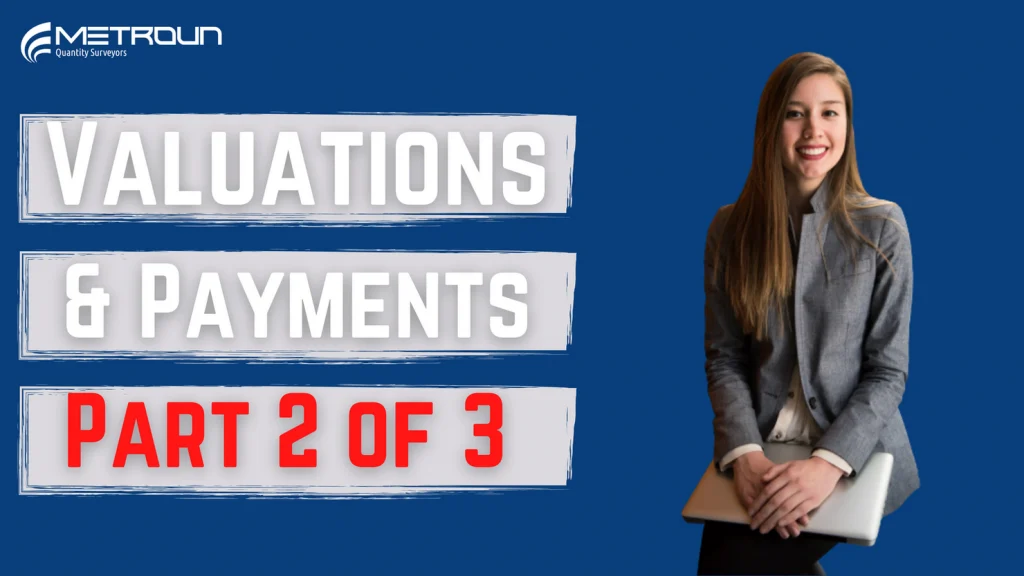In a pervious article we discussed the purpose of valuations in Quantity Surveying and how they serve the interim payment process during the lifecycle of a project. In this article, we are going to delve a little deeper into some of the practical steps on how valuations are carried out.
This article has been made using the information provided by RICS in the Interim valuations and payments 1stedition, August 2015.

The RICS states the following on the purpose of valuations:
“The purpose of interim valuations is to provide advice to the certifier on a construction project for the issue of interim certificates and payment notices. The certifier will be the contract administrator, employer’s agent, the project manager or the employer – depending on the contract conditions being used.”
This article is tailored towards a PQS utilising a JCT contract. However, the below steps should be adhered to where possible in accordance to the contract being utilised.
There are six stages to prepare an interim valuation. These include:
Stage 1: Planning
Stage 2: Pre-valuation
Stage 3: Valuation
Stage 4: Valuation documents
Stage 5: Issue valuation
Stage 6: Post-valuation
Stage 1 Planning
This is carried out prior to contract commencement and includes the following: Understandingthe contract requirements, reviewing the pricing documentation & liaison with the contractor, consultant & clerk of works. During this stage it’s important to understand how and when the valuations are going to be carried out in-line with the payment process. This means that there needs to be an agreement (if not stated in the contract) of the schedule of payment dates withthe employer. There also needs to be an understanding of how the valuation needs to be builtup, and under what various headings. For example, is there a works breakdown structure that needs to be adhered to? The contract documents will need to be reviewed during this stage. There may be factors like retention which need to be considered. Ultimately, this stage needs to lay the foundations for the interim valuation process.
Stage 2 Pre-valuation
This is where the employer will receive the contractor’s interim application and carry out an initial check on the application provided. The employer’s Quantity Surveyor will need to obtainconfirmation from the contract administrator that all works are in accordance with the contract.
Stage 3 Valuation
This is where the employer’s Quantity Surveyor would meet the contractor’s Quantity Surveyor on site and inspect the works carried out. They would assess the work carried out on site through visual inspection and quantify the materials on/off site. From here they would calculate the sums required for the gross valuation, and see how this ties up with the contractor’s application for payment. They would then carry out adjustments and provide reasons for the adjustments. The valuation is then agreed with the contractor’s Quantity Surveyor.
Stage 4 Valuation Documents
This is where the employer’s Quantity Surveyor carries out the final desk check of the valuation and performs arithmetical checks on the valuation. Any errors are then notified to the contractor. Once the employer’s QS is content with the valuation, they will prepare the valuation form along with any statement of retention values and prepare the valuation issue letter for the certifier and contractor.
Stage 5 Issue valuation
In this stage the valuation documentation is reviewed, signed and issued. This is assembled with any other relevant valuation documents. The documents need to be in the correct order i.e, covering letter, valuation form, contractor’s application for payment together with scheduleof adjustments and narrative. The documents will then be given to an independent person to review for any last minute adjustments to be made. The valuation form is then signed and issued to the contractor.
Stage 6 Post valuation
Once the valuation has been issued, a payment notice will need to be provided to the contractor. The amount on the payment notice will need to be verified with the valuation assessment. Once payment has been made, the amount will need to be verified against the payment notice and a record should be kept of the actual amount paid by the employer. All valuation calculations and narrative must be filed for later reference. Keeping records is vital, and will be especially important should the contractor challenge any of the payments through an adjudication.
Why not check out our video on this subject:






